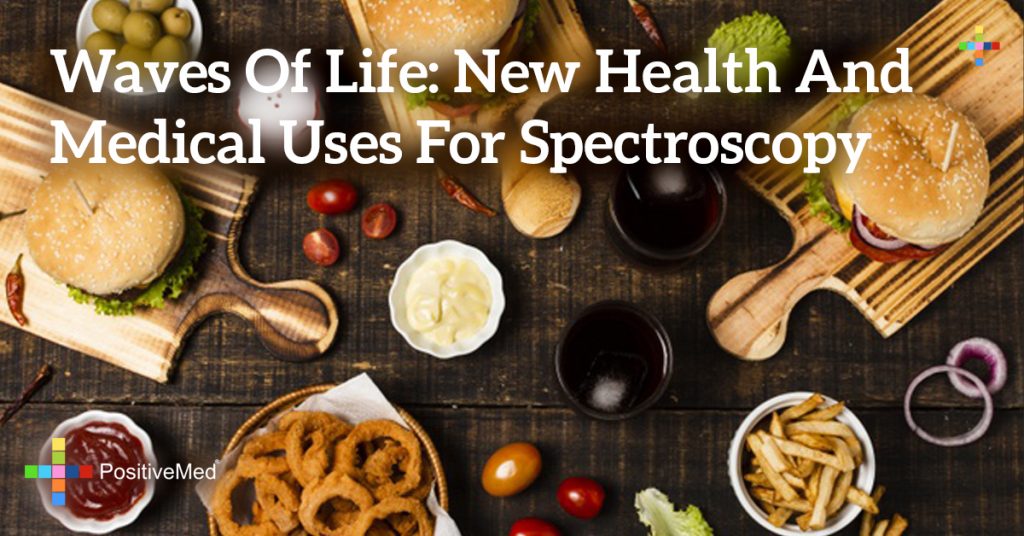
Waves of Life: New Health and Medical Uses for Spectroscopy
You’ve always wondered what’s in your food. Now you’ll know. Some exciting new technology promises to show you what you’re eating. And, when you figure that out, maybe just maybe you’ll be one step closer to figuring out what’s healthy and what’s not.

One of the most exciting things that health experts have seen in recent years comes from a startup company, Consumer Physics. Their latest product is called SCiO, and is a pocket-sized gadget that uses near infrared spectroscopy to tell you how many carbs and calories are in your food.
This same technology is being used in other products, like ToothScan, which can give you a daily tooth scan to tell you about the health of your teeth.
SCiO does something similar, but with food!
Like any spectrometer, the SCiO analyzes the chemical makeup of your food and drinks by working out complex interactions between molecules and light that’s hitting it. By analyzing the unique optical signature of scanned material, you can figure out what it’s made of.
Right now, SCiO should work with anything from food and drinks, pills, plants, and even dogs. The problem is that the current tech limits its usefulness to consumers. You’ll only be able to work out ingredients for heterogeneous foods.
RELATED ARTICLE: 10 Effective Ways To Burn More Calories During The Day
If you point the device at a piece of cheese or bread, it’ll tell you the fat content and the carbs. It comes with an app, and all this data can be integrated to you receive custom tips that can help you better plan your meals out.
This is a boon for those who have a medical condition, like diabetes. Now they can see just how many carbohydrates, and sugar, are in any food. They can also better monitor their protein and fat intake. The device shines a blue light on the object you want to analyze. Then, the data is gathered about the object and information sent to the cloud, where the company analyzes it for you. It then sends the information back to your smartphone in real-time.
Spectrometers aren’t new. They’ve been around for decades. But, most of them cost $20,000 and must be housed in a lab, because they’re large and difficult to transport.No individual could have this in their home.They require specialized knowledge to run. But, the scanner itself does not.

So, the company broke up the sensor from the analysis part of the machine and put it in the palm of your hand. On the back end, there is still a big, unwieldy machine doing all the heavy lifting. But, you don’t need to worry about that. You just need to capture the physical world around you.
Another thing that’s impressive about SCiO is the fact that it’s so accurate. According to its developers, SCiO was scaled down by handling the analysis itself externally. This is why you can hold the sensor in your hand and get information on your smartphone. The sensor doesn’t do any of the analyzing. It just collects the data.
Unlike conventional imaging technologies, like magnetic resonance imaging and computed tomography, the SCiO actually is capable of capturing data that will analyze pretty much anything on the molecular level. And, even with traditional spectroscopy, it’s difficult to study molecules in-vivo because photons scatter when light shines through tissues, and it makes detection of the signal through a spectrometer inefficient.
But, the folks behind SCiO have solved this problem. The new technique works by coding individual photon from a pulsing laser with a megahertz radio frequency. Then, it collects those photons with a detector after they’ve hit and interacted with tissue.
The SCiO scanner was initially conceived by scientists who wanted to change the way this type of scanning works, and who wanted to build a database of of the physical world. There are so many different applications for this technology, too.
Because it can analyze the structure of just about anything in the real world, it could be used to detect fake or contaminated drugs and medications, the quality of food at shipping and receiving docks at grocery stores, and more.

Jewelers can use it to detect the authenticity of gemstones.
You can even create your own custom entries by “teaching” the scanner what it’s looking at. For example, if you want to analyze your own hand, you take a picture of your hand, scan that same area of your hand, and the device “learns” your “signature” for your hand.
The SCiO scanner sells for $250 through Consumer Physics, meaning now everyone can be a scientist and discover the physical world around them.
Alexandra Frost has a medical background and was once planning on becoming a doctor. Life didn’t work out that way as she is now a life coach, but Alex still takes an interest in the latest health breakthroughs and enjoys writing on the subject on occasion.
Disclosure Policy:
This blog is a collaborative blog written by a group of individuals. This blog accepts forms of cash advertising, sponsorship, paid insertions or other forms of compensation. The compensation received may influence the advertising content, topics or posts made in this blog. That content, advertising space or post may not always be identified as paid or sponsored content. The owner(s) of this blog is compensated to provide opinion on products, services, websites and various other topics. Even though the owner(s) of this blog receives compensation for our posts or advertisements, we always give our honest opinions, findings, beliefs, or experiences on those topics or products. The views and opinions expressed on this blog are purely the bloggers’ own. Any product claim, statistic, quote or other representation about a product or service should be verified with the manufacturer, provider or party in question. This blog does contain content which might present a conflict of interest. This content will always be identified.





